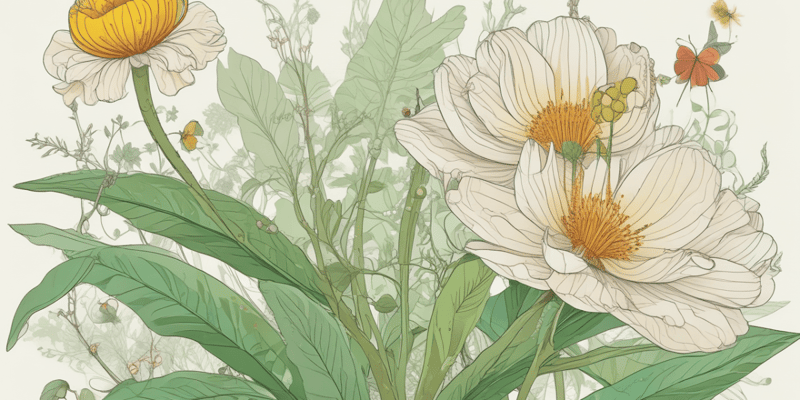Questions and Answers
What is the role of pollinators in plant reproduction?
Assist in seed and fruit production
Which form of pollination involves living organisms?
Biotic pollination
What is the main purpose of colorful flowers in plants?
To attract pollinators
How do wind-pollinated plants disperse pollen?
Signup and view all the answers
What do pollinators receive as a reward for their role in pollination?
Signup and view all the answers
How do some plants attract pollinators through deception?
Signup and view all the answers
What is the key purpose of pollination in plant reproduction?
Signup and view all the answers
Where are male gametes, or sperm cells, produced in a plant?
Signup and view all the answers
What is the role of biotic pollination in plants?
Signup and view all the answers
Which of the following is NOT a type of biotic pollinator mentioned in the text?
Signup and view all the answers
Where are female gametes, or egg cells, enclosed in a plant's flower?
Signup and view all the answers
What happens when male and female gametes fuse during plant reproduction?
Signup and view all the answers
Study Notes
Understanding Plant Reproduction through Pollination
Plants are fundamental to our world, and their reproduction is a fascinating process that ensures their survival and the continuation of life on Earth. One of the most intriguing aspects of plant reproduction is pollination, a delicate dance between plants and pollinators that leads to fertilization and ultimately, the formation of seeds and fruits. In this article, we'll explore the topic of plant reproduction, with a particular focus on pollination.
The Basic Mechanism of Plant Reproduction
Plants reproduce sexually, and this process involves two distinct types of cells: male and female gametes. The male gametes, or sperm cells, are produced in the anther and stored in pollen grains. Female gametes, or egg cells, are produced in the ovule and enclosed within the ovary in a plant's flower.
Pollination: The Meeting of Male and Female Gametes
Pollination is the transfer of pollen from the anther of a flower's male reproductive organ to the ovule of a flower's female reproductive organ, facilitating fertilization. This event is essential for successful reproduction, as the fusing of male and female gametes leads to the development of seeds and fruits.
There are two primary types of pollination:
-
Biotic pollination: This type of pollination involves living organisms, such as insects, birds, bats, and mammals like humans, serving as vectors to transfer pollen from one flower to another. These pollinators collect pollen on their bodies as they visit flowers to feed and then, inadvertently, transfer the pollen to other flowers as they move from one plant to another.
-
Abiotic pollination: This form of pollination is not facilitated by living organisms but by non-living factors, such as wind, water, and gravity. Wind-pollinated plants, such as grasses, rely on wind currents to disperse pollen from one flower to another. In the case of water-pollinated plants, such as some species of aquatic mosses, pollen is dispersed through water, with the pollen grains being carried by currents or floating freely.
Mutual Benefits of Pollination
Pollination benefits both the plant and the pollinator in several ways:
- Plants obtain fertilization, leading to the production of seeds and fruits.
- Pollinators receive food, such as nectar and pollen, as a reward for their role in pollination.
Adaptations to Enhance Pollination
Plants have evolved a variety of adaptations to increase their chances of successful pollination. Some of these adaptations include:
- Colorful flowers: Many flowering plants have evolved brightly colored flowers to attract pollinators to their blooms.
- Fragrances: Some plants produce pleasant scents to attract pollinators.
- Floral structure: The shape and structure of flowers can influence the type of pollinator that they attract.
- Nectar: Nectar, a sugary liquid found in flowers, provides food for pollinators, enticing them to visit the flower.
- Pollinator deception: Some plants have evolved flowers that mimic the appearance of, or produce scents similar to, other organisms, such as female insects, to attract pollinators.
Conclusion
Plant reproduction is a fascinating process that ensures the survival of plants and provides a crucial foundation for the ecological life cycles that sustain our planet. Pollination, the transfer of pollen from male to female reproductive organs, is a central component of this process. By understanding the basic mechanisms of plant reproduction and the role of pollination in this process, we can appreciate the intricate connections that exist between plants and their pollinators. This knowledge also helps us to better understand the ecological consequences of human actions, such as habitat destruction and climate change, which can have far-reaching implications for the health and vitality of our planet's ecosystems.
Studying That Suits You
Use AI to generate personalized quizzes and flashcards to suit your learning preferences.
Description
Test your knowledge about the fascinating process of plant reproduction, with a focus on the essential role of pollination in ensuring the survival and reproduction of plants. Explore the mechanisms and types of pollination, as well as the mutual benefits for both plants and pollinators.




